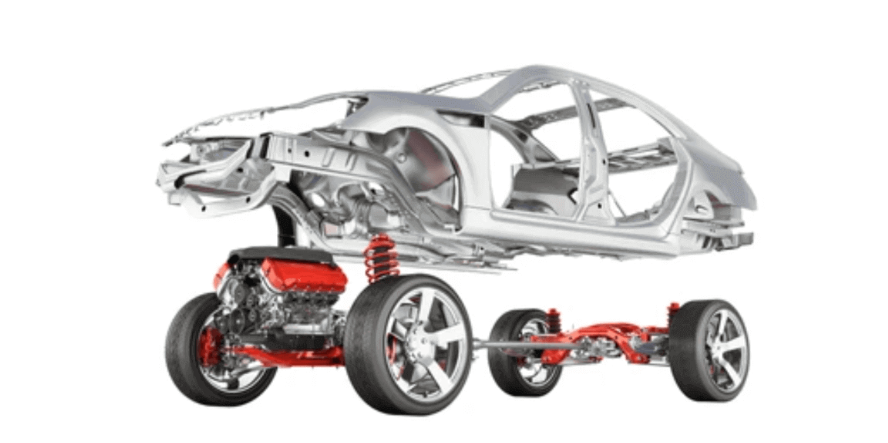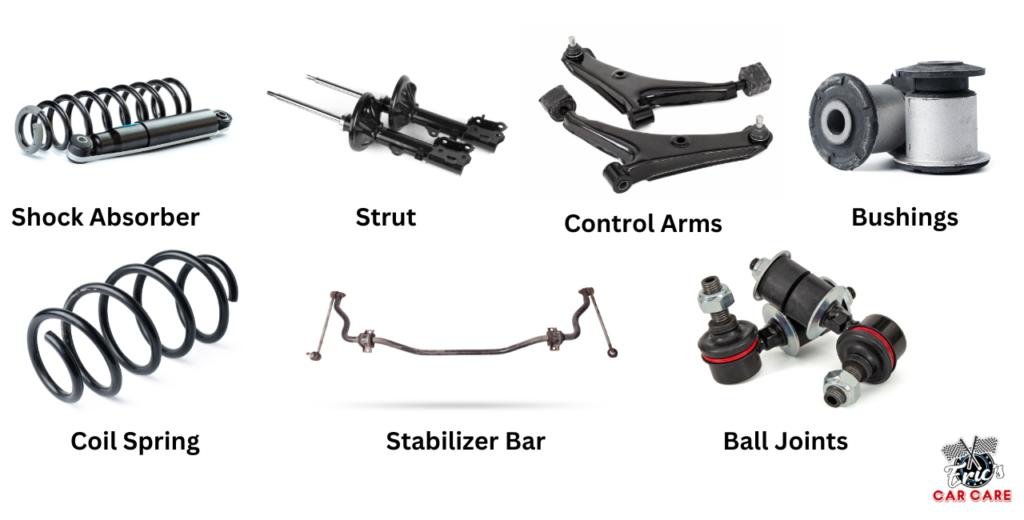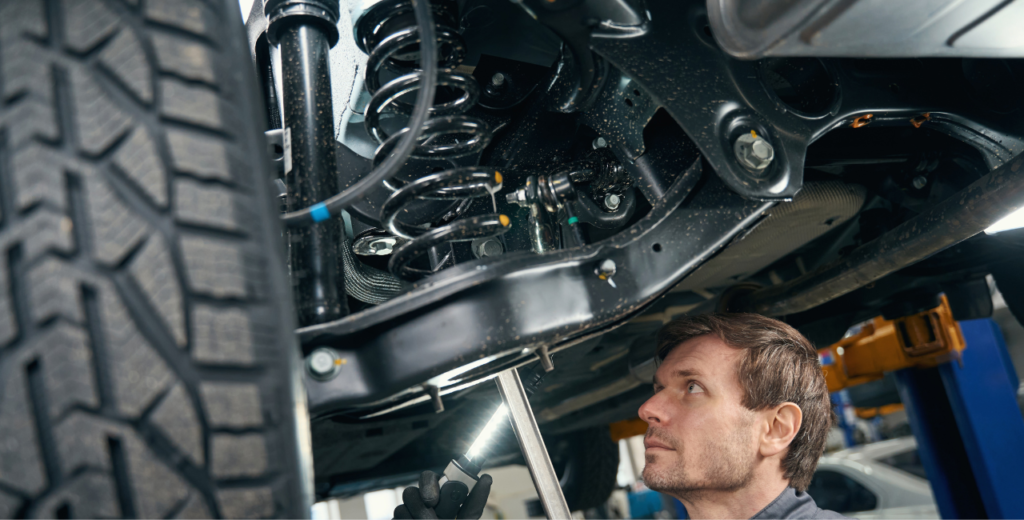A car suspension system is one of the most essential components of a vehicle, playing a crucial role in ensuring ride comfort, handling, and safety. Without an effective suspension system, driving would be uncomfortable, unstable, and even dangerous, especially on rough or uneven road surfaces.
In this blog, we will explore everything you need to know about a car suspension system, including its components, functions, types, and maintenance. If you experience suspension issues, our professional auto repair services can help diagnose and fix the problem, ensuring a smooth and safe driving experience.
Car Suspension System
A car suspension system is a network of springs, shock absorbers, struts, control arms, and other components that work together to absorb road shocks, maintain tire contact with the road, and provide a smooth and controlled driving experience. Steering and suspension services are essential to ensure that all these components function properly, contributing to overall vehicle stability and comfort.
Primary Functions of a Suspension System
A car’s suspension system serves three primary functions:
- Shock Absorption – It minimizes the impact of road imperfections such as potholes, bumps, and rough terrain, providing a smoother ride for passengers.
- Vehicle Stability – It keeps the car stable and prevents excessive body roll during sharp turns or sudden movements.
- Handling and Control – It ensures proper tire contact with the road, improving traction, braking, and overall vehicle control.
Without a properly functioning suspension system, a vehicle would be difficult to steer, uncomfortable to ride in, and unsafe at high speeds.

Car Suspension System Parts
The suspension system consists of multiple components that work together to provide a smooth ride and enhance handling. Below are the main car suspension system parts:
1. Springs
Springs are fundamental to a vehicle’s suspension system as they absorb the impact from road irregularities. There are three main types of springs used in modern vehicles:
- Coil Springs – The most common type used in many modern cars. They compress and expand to absorb shocks.
- Leaf Springs – Typically found in trucks and older vehicles. These consist of multiple layers of metal strips stacked together.
- Torsion Bars – Used in some SUVs and off-road vehicles. They twist under force to absorb shocks.
2. Shock Absorbers (Dampers)
Shock absorbers, also known as dampers, work in conjunction with springs to control unwanted bouncing and movement. Their main function is to convert kinetic energy from the suspension into heat energy, which is then dissipated. Without shock absorbers, a car would continue bouncing after every bump.
3. Struts
Struts are a combination of a shock absorber and a coil spring in one unit. They provide structural support to the suspension system while also absorbing shocks. Struts are commonly found in MacPherson strut suspension systems.
4. Control Arms
Control arms connect the suspension system to the car’s chassis. They allow the wheels to move up and down independently while maintaining proper wheel alignment. Control arms usually contain ball joints and bushings to enable smooth movement.
5. Stabilizer (Sway) Bars
Sway bars help prevent excessive body roll when turning. They connect the left and right sides of the suspension system and work to distribute force evenly during cornering, reducing vehicle lean.
6. Ball Joints and Bushings
Ball joints act like pivot points, allowing for smooth movement between suspension components. Bushings, usually made of rubber or polyurethane, help absorb vibrations and reduce noise.

How Does a Car Suspension System Work?
The suspension system operates by balancing compression and rebound forces when a vehicle encounters road imperfections. Here’s how it works step-by-step:
1. Absorbing Impact
When a vehicle hits a bump or pothole, the wheels move upward. The suspension’s springs compress to absorb the energy, preventing the force from being transferred directly to the vehicle’s frame.
2. Dampening Oscillations
Without shock absorbers, the compressed springs would continue to bounce up and down. Shock absorbers control this movement by dissipating the energy as heat.
3. Maintaining Stability
Control arms and sway bars work together to keep the vehicle stable. They prevent excessive body roll, especially during sharp turns, ensuring even weight distribution.
4. Ensuring Tire Contact
A well-functioning suspension system ensures that the wheels remain in contact with the road at all times. This improves traction and handling, particularly in wet or slippery conditions.
Types of Suspension System
There are two primary types of suspension systems used in vehicles:
1. Independent Suspension
In an independent suspension system, each wheel moves independently of the others. This provides a smoother ride and better handling. Common types include:
- MacPherson Strut Suspension – Used in many front-wheel-drive vehicles for its compact design and cost efficiency.
- Double Wishbone Suspension – Found in high-performance and luxury cars. It offers better control and stability.
2. Dependent Suspension
In a dependent suspension system, both wheels on the same axle are connected. This type is commonly used in trucks and off-road vehicles for added durability. Examples include:
- Solid Axle Suspension – Used in heavy-duty vehicles for strength and stability.
- Leaf Spring Suspension – Common in older vehicles and trucks to support heavy loads.
Signs of a Failing Suspension System
A damaged suspension system can affect your vehicle’s safety and performance. Here are some warning signs to look out for:
- Excessive Bouncing – If the car continues to bounce after hitting a bump, the shocks may be worn out.
- Uneven Tire Wear – Poor suspension can lead to improper wheel alignment, causing uneven tire wear.
- Dipping During Braking – If the front of the car dips forward when braking, it may indicate failing shocks or struts.
- Difficulty Steering – Stiff or unresponsive steering could be a sign of worn-out suspension components.
- Noisy or Rough Ride – Clunking or creaking sounds when driving may indicate damaged control arms, bushings, or struts.
Why Is the Suspension System Important?
A well-maintained suspension system is crucial for:
- Safety – It enhances braking and stability, reducing accident risks.
- Comfort – It absorbs road shocks, making driving more enjoyable.
- Handling – It improves traction and steering responsiveness.
- Tire Longevity – Proper suspension alignment helps prevent premature tire wear.
How to Maintain a Car Suspension System
Regular maintenance ensures optimal performance and longevity. Here are some key maintenance tips:
- Inspect Shocks and Struts Regularly – Look for leaks or damage and replace them every 50,000 miles or as needed.
- Check Tire Alignment – Misaligned tires can strain the suspension system.
- Lubricate Moving Parts – Ball joints and bushings should be properly lubricated.
- Replace Worn-Out Bushings – Damaged bushings can lead to excessive noise and instability.
- Monitor Suspension Height – A sagging suspension could indicate a broken spring or worn-out struts.
Expert Suspension Repair at Eric’s Car Care
The car suspension system is a critical component that ensures stability, comfort, and safety. Understanding how it works and maintaining it properly can enhance your driving experience and prolong the lifespan of your vehicle. If you notice any signs of suspension failure, bring your car to Eric’s Car Care for a thorough inspection and expert repairs. Our skilled mechanics will ensure your suspension system is in top shape, so you can enjoy a smoother, safer ride on the road.

